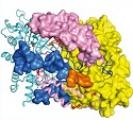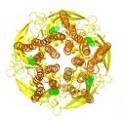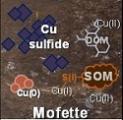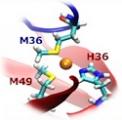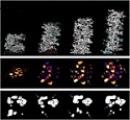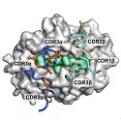Our genetic information is stored in DNA using just four nucleotide bases: A, C, G, and T. While we may never understand how these particular molecular combinations came to store the instructions for all life on Earth, we can address some questions about their role, such as: are these the only four bases that could create a DNA double helix with the right balance of stability and flexibility for cells to store and access genetic information? A team of scientists answered this question by introducing four new, synthetic bases into DNA, forming “hachimoji DNA,” named using the Japanese words for eight letters.
Approximately 1,700 scientists visit SSRL annually to conduct experiments in broad disciplines including life sciences, materials, environmental science, and accelerator physics. Science highlights featured here and in our monthly newsletter, Headlines, increase the visibility of user science as well as the important contribution of SSRL in facilitating basic and applied scientific research. Many of these scientific highlights have been included in reports to funding agencies and have been picked up by other media. Users are strongly encouraged to contact us when exciting results are about to be published. We can work with users and the SLAC Office of Communication to develop the story and to communicate user research findings to a much broader audience. Visit SSRL Publications for a list of the hundreds of SSRL-related scientific papers published annually. Contact us to add your most recent publications to this collection.
The massive consumption of fossil energy and the associated environmental deterioration have led to global concern that calls for innovations in energy technologies. Energy storage is a vital component in this field because it could facilitate ground breaking changes in modern lifestyle by affecting how the energy is stored, transported and consumed. The deployment of lithium ion battery in electric vehicles (EVs) is a good example of this kind, which, however, puts stringent requirements on their rechargeable batteries, including high energy density, high power density, long cycle/calendar life and low cost.
Acute lymphoblastic leukemia (ALL) is an aggressive malignancy of the bone marrow that currently stands as the most common form of cancer in children. DNA sequencing studies comparing diagnostic and relapse patient samples have identified relapse-driving mutations in the cytosolic 5’-nucleotidase II (NT5C2) gene. The role of the NT5C2 enzyme is to degrade purines so they can be exported from the cell. NT5C2 can also degrade and inactivate thiopurine chemotherapy molecules, causing resistance to ALL treatments.
General anesthetics like alphaxalone (5α-pregnan-3α-ol-11,20 dione) bind to type A γ-aminobutyric acid receptors (GABAARs), which are gated ion channels that reduce the potential of neurons to fire. Experimental evidence points to GABAAR’s transmembrane domain (TMD) as the allosteric site of drug binding. The TMD is known to be responsible for allowing the ion channel to transition between the resting, activated, and desensitized states. A team of scientists has studied where alphaxalone binds to GABAAR and how this affects its function.
While a small amount of copper is essential for living organisms, too much copper contaminating our soils can be toxic and pose a serious problem. Copper has an affinity for organic matter in soils, where it mainly exists in the two redox states Cu(I) and Cu(II). In soils that fluctuate in redox conditions, the mobility of copper through the environment can be hard to predict. Mofette sites, produced by CO2 degassing usually found in seismically active areas, are good natural laboratories due to their wide range of soil redox conditions and of soil organic matter composition within a small area. Near the sites of CO2 degassing, the soil is anoxic and organic matter does not decompose well. The soils transition to oxic conditions just a few meters away. A team of researchers studied the behavior of copper in the natural gradient of a mofette site in the Czech Republic.
To defend against infections, our phagocyte cells form a vesicle called a phagosome around pathogens, which then merges with a lysosome to form a phagolysosome. To terminate the threat, the phagolysosome gives the invading cell toxic doses of copper. However, some bacteria have evolved mechanisms for pumping the copper back out of the cell, avoiding toxicity. Understanding the enzymes involved in these complicated processes is important to our understanding of disease.
Many new electronic devices replace traditional silicon chips with silicon carbide (SiC) semiconductor chips, which are able to handle more power, function with less power loss, and operate at higher temperatures. Because these chips generate more heat, new materials that bond the chip to the heat sink are needed. A promising choice is sintered silver (Ag). However, detailed and quantitative information about the pore structure and evolution during aging of sintered Ag have not been well studied. A team of researchers quantitatively analyzed the pore structure of sintered silver at high temperatures over time.
T cells allow our immune system to respond to specific antigens from infectious agents. Each T cell hosts a receptor (TCR) that binds to a particular antigenic peptide ligand. If the receptor is exposed to the ligand it recognizes, the T cell is activated. A team of researchers used a variety of methodologies including protein engineering, x-ray crystallography, single molecule techniques, and molecular simulations to understand how T cells recognize their ligands and subsequently how T cells are activated.
The central dogma of molecular biology posits that the genes in our DNA are transcribed (or “copied”) into messenger RNAs (mRNA), which are then translated (or “read-out”) into the proteins that make up our cells and tissues. Control of gene expression is critical to human health and development.. One major mechanism of regulation involves very small RNAs called microRNAs (miRNAs). miRNAs regulate genetic information post-transcription by binding to mRNAs and preventing translation into proteins. It is estimated that about half the protein-coding genes in the human genome are regulated by a miRNA, and breakdown of miRNA systems is increasingly associated with human disease, including many forms of cancer. A central question in miRNA biology is: how do these tiny RNAs effectively regulate mRNAs, which are hundreds or even thousands of times their size?
Materials that act as superconductors at higher temperatures (as high as -70°C) are a subject of intense research, due to their use in magnets and quantum devices, including advanced medical and scientific instruments. Interactions of many quantum-level variables in superconducting materials make these systems difficult to model. The Hubbard Model, proposed in 1963 to explain the behavior of correlated electrons in solid materials and 20 years later applied to high-temperature superconducting materials, has been favored due to its relative simplicity along with limited experimental verification. This model focuses on the exclusively electronic variables for superconductivity, completely neglecting atomic-scale vibrations (termed phonons) of the lattice of the material. A team of scientists has challenged the assumption that phonons do not impact high temperature superconductivity through studying a cuprate material.



